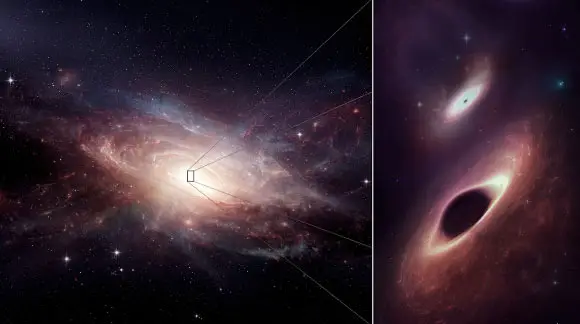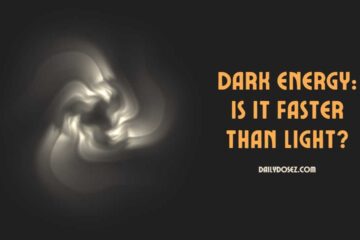Astrophysicists have made groundbreaking strides in solving a longstanding cosmic mystery known as the “final parsec problem.” This problem has puzzled scientists for years, as it seemed to prevent supermassive black holes from merging. However, new calculations reveal that dark matter particles play a crucial role in facilitating these cosmic unions.
A Background Hum of Gravitational Waves
In 2023, researchers detected a pervasive “hum” of gravitational waves throughout the Universe. They proposed that this background signal originated from millions of merging pairs of supermassive black holes, each with masses billions of times greater than our Sun. Yet, simulations indicated a perplexing halt in their merger process when the black holes approached within a parsec (3.26 light-years) of each other.
The Final Parsec Problem
This stalling, known as the “final parsec problem,” conflicted with the idea that merging supermassive black holes were the source of the gravitational wave background. It also challenged the notion that these black holes grow from the merger of smaller black holes. Dr. Gonzalo Alonso-Álvarez, a postdoctoral researcher at the University of Toronto and McGill University, along with his team, has shed light on this issue.
The Role of Dark Matter
Dr. Alonso-Álvarez explains, “We show that including the previously overlooked effect of dark matter can help supermassive black holes overcome this final parsec of separation and coalesce.” Their new model suggests that dark matter particles interact in ways that maintain the density of the dark matter halo around the black holes. This interaction ensures that the supermassive black holes continue to spiral inward until they merge.
Merging Galaxies and Black Holes
When galaxies collide, their central supermassive black holes begin to orbit each other. Nearby stars exert gravitational forces that slow them down, causing the black holes to spiral closer. Previous models suggested that as the black holes approached within a parsec, they scattered the surrounding dark matter, halting their inward spiral. However, the new model shows that dark matter particles can interact in a way that keeps their density high, facilitating the merger.
Implications for Gravitational Wave Detection
This discovery has significant implications for our understanding of gravitational waves. The background hum detected by Pulsar Timing Arrays, which measure tiny variations in signals from pulsars, is made up of longer-wavelength gravitational waves than those detected by LIGO in 2015. Professor James Cline from McGill University and CERN noted, “A prediction of our proposal is that the spectrum of gravitational waves observed by pulsar timing arrays should be softened at low frequencies. The current data already hint at this behavior, and new data may confirm it in the next few years.”
Insights into Dark Matter
The new findings also provide a window into the nature of dark matter. Dr. Alonso-Álvarez said, “Our work is a new way to help us understand the particle nature of dark matter. We found that the evolution of black hole orbits is very sensitive to the microphysics of dark matter, which means we can use observations of supermassive black hole mergers to better understand these particles.”
The researchers discovered that the interactions they modeled could also explain the shapes of galactic dark matter halos. Dr. Alonso-Álvarez concluded, “The final parsec problem can only be solved if dark matter particles interact at a rate that can alter the distribution of dark matter on galactic scales. This was unexpected and exciting.”
This groundbreaking research not only solves a cosmic puzzle but also opens new avenues for understanding the Universe’s most mysterious substance: dark matter.




